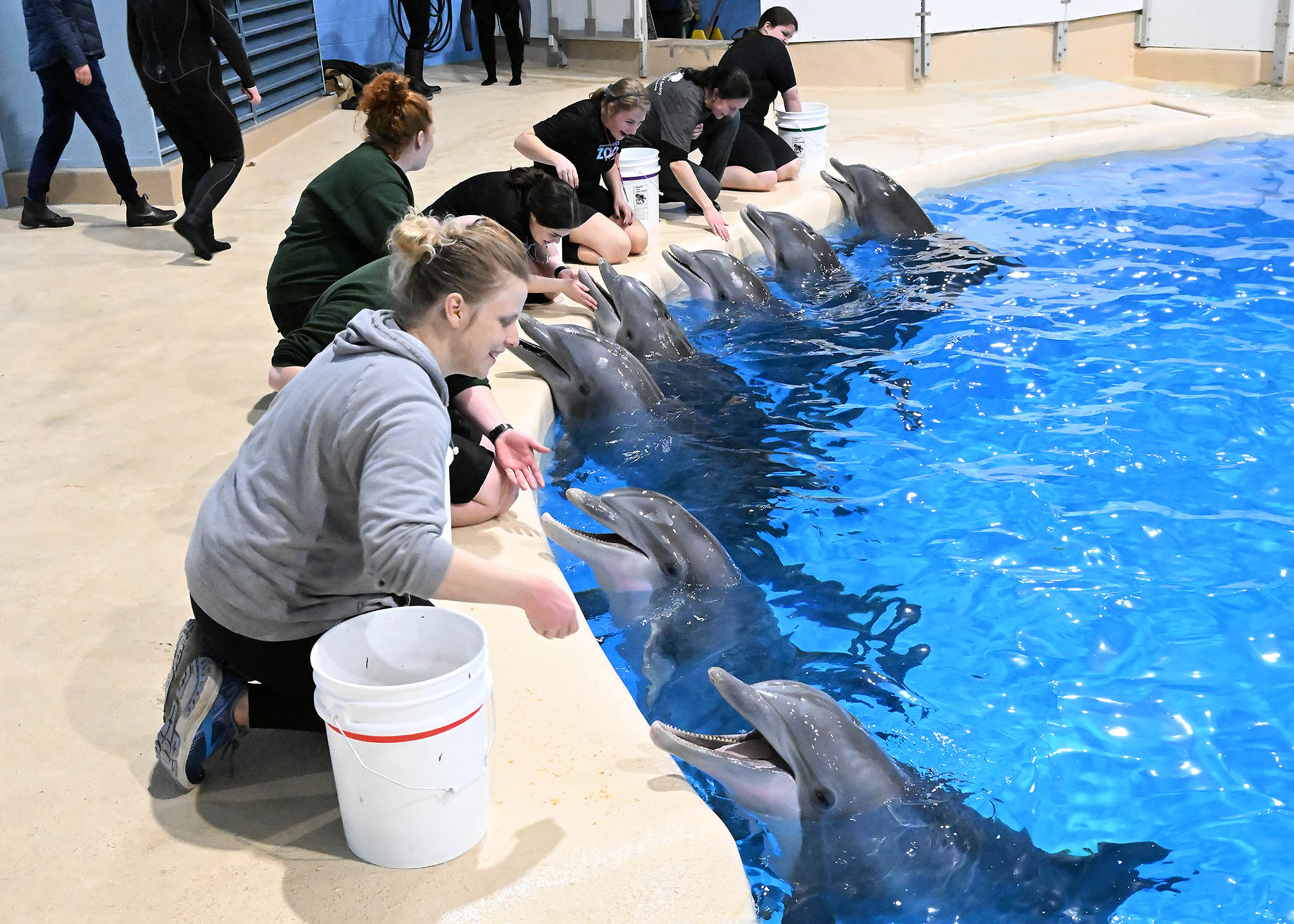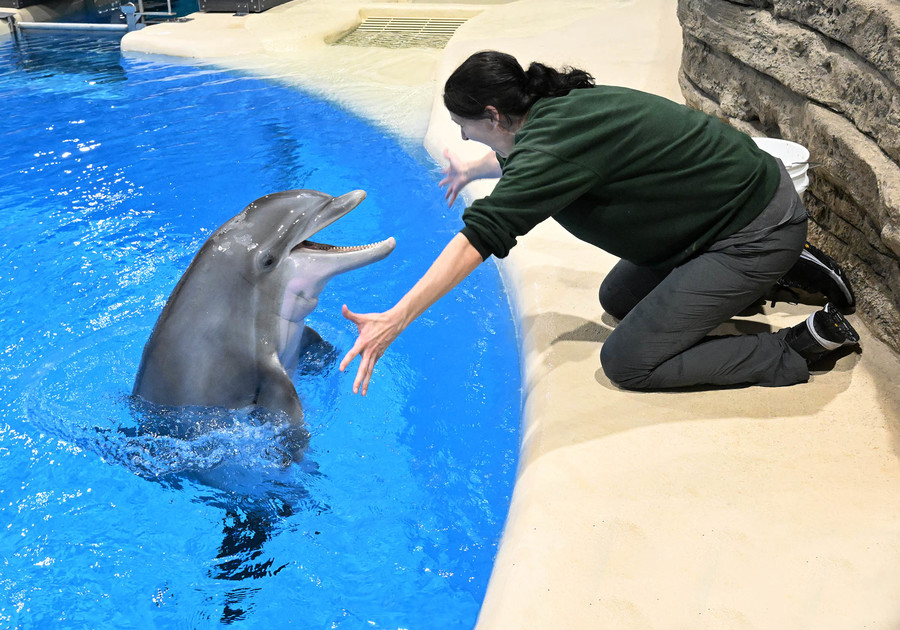Brookfield Zoo is thrilled to announce that its seven bottlenose dolphins have made their journey home to Chicago following the completion of an extensive $10 million renovation to their Seven Seas habitat. For the next month and a half, the building will remain closed to guests while the dolphins—Lucky, 50; Tapeko, 42; Allie, 36; Kai, 29; Spree, 21; Noelani, 20; and Allison, 18— become reacclimated to their environment. Dolphins in Action presentations are scheduled to resume on March 22, and guests will be able to see the animals from the Underwater Viewing Gallery beginning March 25.
For the past 15 months, the dolphins have been at fellow Association of Zoos and Aquariums’ accredited Minnesota Zoo being cared for by Brookfield Zoo’s marine mammal team, who provided daily care to the dolphins and engaged with them in the same manner they do in Chicago.
 |  |
The significant makeover to the 37-year-old facility aimed to enhance both animal wellbeing and guest experience. “One of our priorities in the project was to add a variety of dynamic elements to the dolphins’ habitat to enrich their daily lives,” said Dr. Michael J. Adkesson, president and CEO of the Chicago Zoological Society and director of Brookfield Zoo. “These new features will make our already world-class care for our dolphins even more robust.” The renovations were driven in part by results of the Cetacean Welfare Study published in 2021 that evaluated care of dolphins and whales in 43 zoos and aquariums around the globe. The Chicago Zoological Society and Brookfield Zoo’s Conservation Science and Animal Welfare Research Department spearheaded this project. “Based on scientific results we know that dynamic enrichment programs and social management of bottlenose dolphins are much more linked to positive welfare than environmental characteristics such as habitat size. While making it a more dynamic environment for the animals, we also hope the changes will be exciting for our guests who come to see these charismatic marine mammals,” Adkesson added.
The upgrades to the dolphins’ environment will encourage natural behaviors, including searching for food, playing, utilizing their echolocation abilities, chasing objects, and interacting with each other. New additions in the dolphins’ habitat include rockwork structures with anchors that animal care staff can attach a variety of enrichment items, such as kelp strips and floating objects, at different levels in the water. Located in the rockwork on the northeast side of the habitat, there is a shallow sand pit, where staff can hide enrichment items or food. The dolphins can use their echolocating skills to find buried objects. During echolocation, a dolphin emits high-frequency sounds that travel through the water, bounce off objects, and return to the animal as echoes, which they use to locate and identify an object. The two center rock elements also have built-in bubbler systems. The dolphins can play with the bubbles, roll over them, or even maneuver an object like a ball over the bubbles to propel it. The bubbles also disrupt echolocation signals, allowing the animals to engage in a sort of underwater hide-and-seek.
| In addition to infrastructure needs made inside the building, several aesthetic and storytelling elements for guests have been adopted as well. Exhibit theming now reflects the Sarasota Bay, Florida, area where the Chicago Zoological Society’s Sarasota Dolphin Research Program is based. The Program, now in its 55th year, is the longest-running study of dolphins in the wild that has provided information on the species’ biology, behavior, health, ecology, social structure, and communication that has benefited marine mammal conservation programs around the globe. “Showcasing our conservation fieldwork in Florida with guests emphasizes that our commitment to caring for wildlife extends far beyond Brookfield Zoo’s 235 acres to programs around the world. Sharing our passion for wildlife and nature can be a powerful catalyst to inspire others to also take action and care about preserving the natural world,” said Adkesson. |  |
The former Caribbean-themed façade has been removed and the building has been redesigned to depict the natural environment of Sarasota Bay. New artificial plantings that replicate species found in the Sarasota area, including mangrove trees and tall grasses, add to the ambiance throughout the stadium. Adkesson shares that, “Through scientific monitoring, we know that dolphins in Sarasota Bay spend their lives in the shallow waters of the Bay in a relatively small area. We wanted to bring that environment to our guests here in Chicago to help them understand the importance of marine conservation.”
Additionally, hydrophones (underwater microphones) have been installed to allow researchers and staff to listen to the animals’ vocalizations, which will be valuable for scientific studies. When turned on, guests will also be able to hear the dolphins through the building’s sound system. And, upgrades to the overhead cameras will also aid in future research efforts as well as monitoring the animals. Later this year, the Zoo is planning to install a 35-foot-diameter moveable floor in the south holding pool. This will allow staff to raise the lift along with a dolphin in a quick, low-stress manner for any medical care that may be needed.
Other upgrades include a new roof, skylights, and lining to the pools. Fluorescent lighting has been replaced with LED lights, making it more environmentally friendly and energy efficient. A new heating and cooling system allows for a better temperature-controlled climate in the building year-round and features a high-quality ventilation system, making the airflow better for both the animals and guests. And, two center front rows of benches have been removed to accommodate accessibility seating for wheelchairs during presentations.
Seven Seas’ Underwater Viewing Gallery also received a refresh, including new signage and lighting projections. New digital monitors provide a look at the behind-the-scenes dolphin science and research conducted both at Brookfield Zoo and in Sarasota Bay, Florida. Much of what is discovered at the Zoo helps to develop methods and technology needed to study wild dolphin populations. In turn, information gathered from studies on wild dolphins is used to continually improve animal wellbeing at Brookfield Zoo. Additionally, zoogoers will learn the important role science plays in maintaining healthy ecosystems and wildlife populations as well as personal actions they can take to make a difference for animals everywhere.
The Seven Sea’s renovations were made possible in part by funding provided by the American Rescue Plan Act through Cook County and the Forest Preserves of Cook County as well as many generous donors. The building’s roof renovations are funded in part by the Public Museum Capital Grant Program through the Illinois Department of Natural Resources and the Illinois State Museum.



